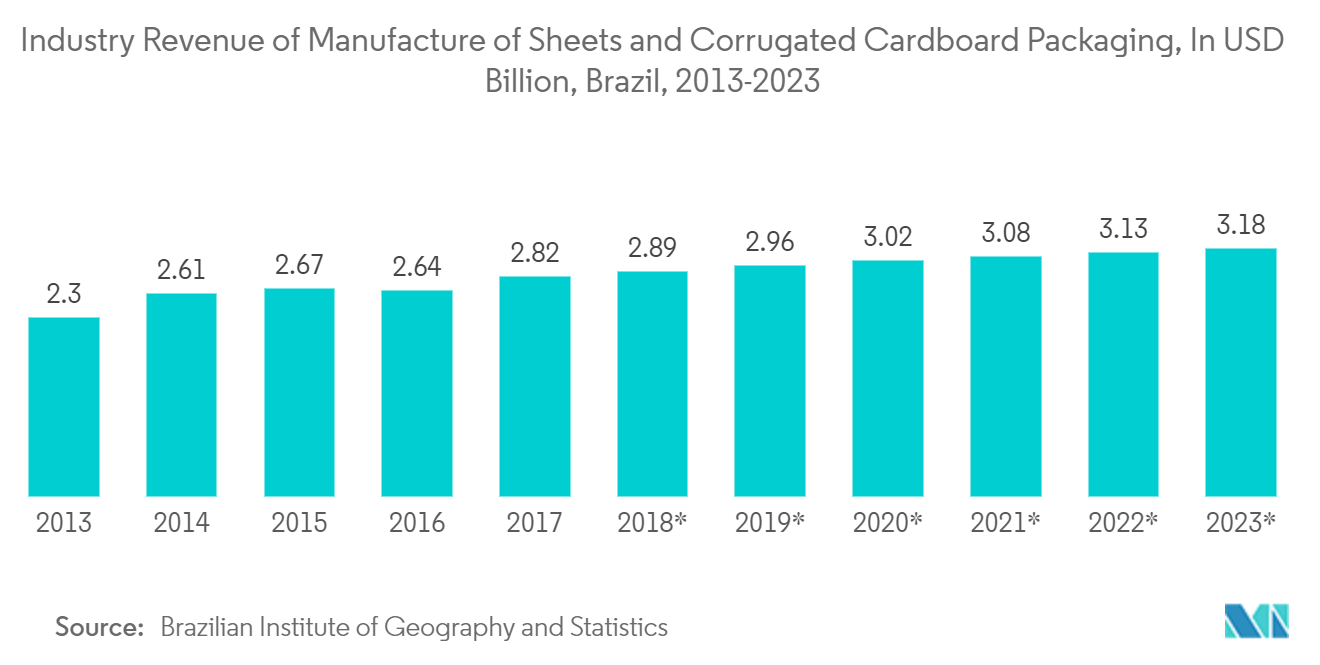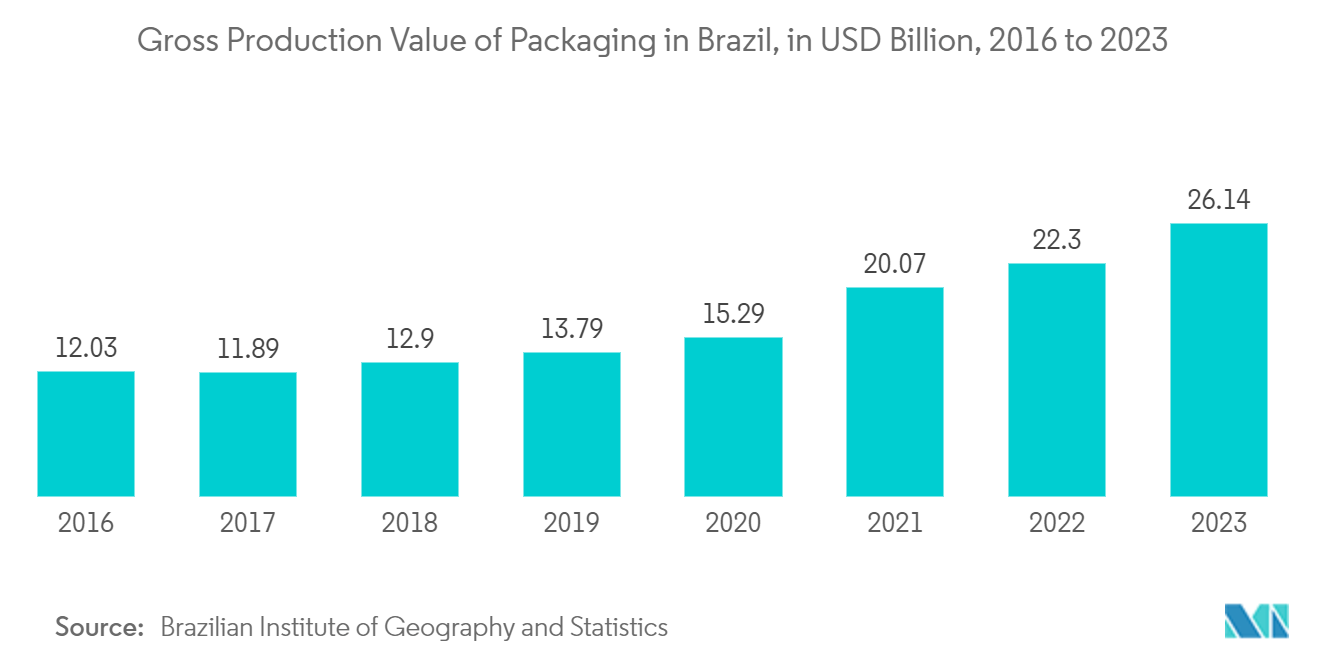Market Trends of Brazil Packaging Industry
Paper and Paperboard to be the Fastest-growing Segment
- The paper packaging market in Brazil is witnessing a surge, propelled by its eco-friendly attributes. Paper packaging, being lightweight, biodegradable, and recyclable, emerges as a sustainable choice. Moreover, its versatility and cost-effectiveness make it pivotal in the transportation, preservation, and protection of diverse products, bolstering the country's packaging market. Notably, Brazil's paper and pulp industry stands out as a leading agricultural exporter, securing a prominent global position.
- With its versatility and eco-friendly appeal, paperboard packaging stands out as a favored choice. Its adaptability in size, coupled with a compact footprint, sets it apart from bulkier alternatives, rendering it a versatile option across diverse end-user industries. Brazil, notably, emerges as a key player in the South American corrugated cardboard market. Projections from the Brazilian Institute of Geography and Statistics indicated a growth trajectory, with the nation's output of sheets and corrugated cardboard packaging anticipated to reach from a production value of USD 2.89 billion in 2018 to USD 3.18 billion by 2023. These trends not only underscore the rising prominence of paper packaging but also signal growing opportunities for industry participants.
- For instance, Klabin, the leading packaging paper producer in Brazil, continued its efforts to enhance paper integration by implementing its strategy in 2023. Following significant investments in virgin paper production, the company completed the initial phase of a BRL 188 million (USD 35.7 million) investment at its Horizonte packaging unit in Ceará state, located in northeastern Brazil. This investment involved the installation of a new corrugator, which will significantly increase the unit's capacity to produce corrugated board packaging. The upgraded capacity will reach 100,000 tonnes per year, a substantial increase from the previous capacity of 20,000 tonnes per year.
- The environmental advantages linked to paper packaging play a crucial role in propelling the growth of the paper packaging market in Brazil. The majority of paper and paperboard containers are crafted from unbleached paper, which is more environmentally friendly due to its biodegradability. The food industry is increasingly embracing paper packaging because of its lightweight, biodegradable, and recyclable characteristics, positioning it as an eco-friendly choice. Brazil notified the WTO in January 2023 about its plans to amend its Resolution on food contact packaging, a move that is anticipated to drive up the demand for paper packaging.
- Paperboard offers stability and strength to packaging, featuring an internal polyethylene layer that effectively seals liquid contents, making it a top choice for packaging liquid milk. Brazil's dairy industry has recently undergone significant changes in both production and structure. According to USDA estimates, milk production was expected to increase by approximately 4.3% in 2023, reaching 24.7 million metric tons (MMT). By 2024, milk production is forecast to grow by around 1.2%, reaching 25 MMT. These notable production capabilities will further drive the adoption of paperboard packaging methods.
- The increasing demand for innovative packaging is one of the key drivers behind the expansion of the paper packaging industry in Brazil. The adoption of intelligent paper packaging is anticipated to drive the demand for such products in Brazil over the forecast period. These packaging solutions play a crucial role in minimizing greenhouse gas emissions, thereby decreasing the overall carbon footprint. Paper-based containers are considered more environmentally friendly compared to plastic alternatives, which has made them increasingly popular among consumers in Brazil. This shift toward sustainable and eco-friendly packaging is forecast to continue fueling the market's growth over the forecast period.

Pharmaceutical Expected to be the Fastest-growing End-user Industry
- Brazil holds a significant share in the Latin American pharmaceutical market and is considered a well-established pharmaceutical market within the region. The country offers great potential for big pharma manufacturing, with local companies leading the way in terms of the products available. Various product innovations, particularly in pharmaceutical packaging, have been observed in the Brazilian market due to the presence of numerous vendors. The growing investments in the country's pharmaceutical industry are anticipated to boost the need for advanced packaging solutions.
- Pharmaceutical packaging is crucial for maintaining the quality, safety, and effectiveness of medications in accordance with regulatory guidelines. Brazil, being a key player in the pharmaceutical market worldwide, has specific regulations and packaging standards. One common type of pharmaceutical packaging in Brazil is blister packaging, which involves a plastic sheet with separate cavities for each medication dose, sealed with a foil or plastic cover. The increasing investments in the expansion of pharmaceutical manufacturing facilities will drive the demand for such packaging techniques.
- In Brazil, injectable drugs and vaccines are often packaged in glass vials and ampoules. These containers are renowned for their remarkable sterility and ability to accommodate a diverse range of pharmaceutical formulations. On the other hand, plastic bottles are widely used in Brazil to package liquid pharmaceuticals like syrups, suspensions, and oral solutions. These bottles come in different sizes and are selected for their flexibility, cost-effectiveness, and user-friendly nature. Furthermore, glass bottles continue to be the preferred option for specific pharmaceutical products in Brazil, particularly those with delicate formulations and high value.
- Similarly, the Government of Brazil initiated measures in June 2023 to rejuvenate the Union of South American Nations, also known as UNASUR, with the aim of promoting pharmaceutical trade and elevating disease response standards throughout the region. As the possessor of the world's largest government-operated public healthcare system and the continent's largest economy, Brazil is currently at the forefront of South America's efforts to enhance pharmaceutical research and production, while diminishing reliance on foreign medical imports from the United States, China, and Russia. These noteworthy advancements in the pharmaceutical market within the region will undoubtedly bolster the prospects of the Brazilian packaging market.
- The Brazilian pharmaceutical market is experiencing tremendous growth due to various factors. Firstly, the region's pharmaceutical production is expanding, leading to an increase in the availability of over-the-counter medicines. Additionally, local businesses have made significant investments in this market, further contributing to its growth. As a result of these trends, there is a rising demand for pharmaceutical packaging across the country. For example, União Química, a prominent drug manufacturer in Brazil, is considering new acquisitions in both domestic and international markets to expand its reach in different therapeutic fields and geographical locations.
- In addition, the demand for plastic packaging in the pharmaceutical industry has witnessed a significant surge due to its unmatched capabilities. The surge in concerns regarding sustainability, along with increased initiatives to enhance recycling rates and minimize environmental impact, has propelled the growth of plastic bottles used in the pharmaceutical industry. Additionally, the progress in technology and the increasing utilization of plastic bottles for both solid and liquid oral medications have played a crucial role in expanding the market for this packaging format in the pharmaceutical industry.


